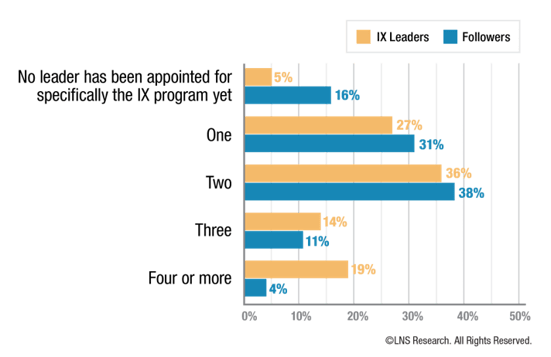The IX Platform Market Continues to Evolve
LNS Research Fellow Tom Comstock provides an IX Platform update in anticipation of the forthcoming IX Analytics Solution Selection Matrix, coming...
Every year, LNS Research analysts put forth predictions around the Industrial Transformation (IX) topics where we focus our research. In December 2020, I made five predictions for 2021. This year I am going to make only one prediction – in multiple parts – but I will drill into that one prediction more extensively. To help you to decide whether my multi-part prediction for 2022 is worth considering, I am concluding this blog post with an assessment of how I did in my 2021 predictions (spoiler alert: by my count, I was 4 out of 5 but you can decide).
LNS Research was the first company to define the Industrial Internet of Things (IIoT). As such, we are believers in the market impact of IIoT technologies. We continue to believe that IIoT technologies have significant potential to disrupt markets and meaningfully impact the financial performance of industrial enterprises. Yet, we see 2022 as a key year of reset in the marketplace. Let’s drill into why we see that reset and the ramifications of it.

Before I drill into the reset, let me comment on the word “again” in my prediction. In many ways, the IIoT market was defined by GE in their Predix heyday when they were forecasting hyper-growth of IIoT generally and their digital business specifically. The focus was on the potential of “things” to connect to the internet and redefine their capabilities (for example, light bulbs were going to detect gunshots) and whole industries were going to move toward “servitization” of assets (the procurement of hard assets in an “as-a-service” utility model rather than a capital expenditure). We all know where that first wave of IIoT – let’s call it IIoT 1.0 – ended: restructuring at GE Digital as their hyper-growth never materialized. The vision may have been correct but the technology could not yet deliver on the hype and the expected industrial disruption never materialized.
This led to a reset to something that might be called IIoT 2.0. Companies like Siemens, Software AG, C3, and Tulip more succinctly defined the near-term impact of IIoT: increasing an industrial organization's competitiveness by providing insight into and better control over industrial operations. By connecting to more data sources and contextualizing that data more effectively, these companies were able to deliver powerful, actionable insights into operations. Servitization was still a focus, especially for machine builders, but other use cases came to the forefront and the overall market dynamics changed. Smart Connected Products are now only one of seven categories of IX Use Cases tracked by LNS Research. We also see Connected Operations, Connected Assets, Connected Supply Chains, Customer Experience, Sustainable Operations, and Connected Frontline Workers. In LNS Research vocabulary, IIoT technologies became IX Platforms.
In addition, as outlined in numerous blog posts and our IX Platform Solution Selection Matrix, the hyperscalers (Microsoft, Amazon, Google, Alibaba) are commoditizing the core IIoT capabilities. Need connectivity, the hyperscalers have a myriad of options to offer with their platforms. Need data contextualization, data lake technology, and general advanced analytics, the hyperscalers again have a myriad of options to offer.
We see the IIoT/IX Platform market in the beginning stages of yet another reset. We think 2022 will see the birth of IIoT 3.0. There are four parts to that reset.
In a world in which machine and equipment connectivity was largely available, IIoT was originally about new technologies to connect to “devices” and “things” that had not historically been connected to the internet. The innovation was the ability to get data from new sources (light blubs, consumer appliances, cars for example) that previously had been impossible or cost-ineffective to get to. IIoT went further to provide analytics on that data to provide real use and status data. Given the volume of the data, data historian technology was widely deployed to store the data, move into a data lake, and advanced industrial analytics (including but not limited to artificial intelligence) deployed to gain new insights. In manufacturing it meant new sensors and data sources, using new communication and integration protocols to extend and enhance the understanding of larger assets and the plant overall.
But then IIoT became trendy. Start-up valuations increased if a company could somehow force themselves into the IIoT box so the label started to be abused. Manufacturers initiated Digital Transformation initiatives and sought to deploy advanced technologies so every vendor latched unto the trend by positioning their legacy products as AI-enabled and/or IIoT. And analysts had not yet provided rigorous enough definitions to help sort out the hype.
Clearly “IIoT” is now being used to cover both machine and “device” connectivity and virtually every vendor that has some form of machine integration capability is relabeling it IIoT. IIoT has become meaningless. LNS Research regularly sees companies relabeling their weak machine integration technologies IIoT. An OPC or SECS/GEMS interface alone is not IIoT but you sure would not know it from how vendors, and now even some manufacturers, are using the phrase.
This is only going to get worse as laggards will follow the leaders in mislabeling capabilities.
Our recommendation for manufactures is not to go buy an IIoT solution nor use IIoT as a requirement. Rather we would encourage manufacturers to seek out IX Platforms and to specify the capabilities sought (integration technologies, types of analytics) precisely.

IIoT 3.0 will be defined by the continued and amplified trend toward vendor specialization outlined in our earlier “Market Dynamics” blog post. Very specifically, LNS Research is forecasting the continued specialization of vendors into a focus on industrial data hubs or advanced industrial analytics.
All in all, at LNS Research, we are saying what once was one market is fragmenting into multiple markets and vendors are going to have to choose where they want to compete. Multiple IX Platform/IIoT vendors reported inconsistent competition and uneven sales success. Part of that confusion is caused by manufacturers:
Industrials are not familiar enough with the alternatives to know which technologies to be evaluating against each other.
Industrials are evaluating a wide array of technologies to determine their potential impact, if any, on their organization. Therefore, while vendors may see themselves as competing with each other, they are really competing to show which solution can bring the most value to the manufacturers.
But a bigger part of the problem is that the technical challenges are very different. Vendors must, at a high level, offer two distinct sets of capabilities:
Get the data into context. That means they must have a wide range of connectivity options, the ability to transport the data to where it needs to be, put it into a meaningful context, and manage that data volume over time. At LNS Research, we are increasingly calling these capabilities an Industrial Data Hub and will be writing about them extensively in 2022.
Make something meaningful of that data, including but not limited to applying artificial intelligence/machine learning algorithms against that data. This is what LNS Research is calling Advanced Industrial Analytics and we will be delivering a Solution Selection Matrix in early 2022.
The same vendor could deliver both sets of capabilities as we outlined in our IX Platform SSM in 2021. Increasingly, we expect vendors to specialize in one or the other of these sets of technology. In fact, by the time we go to update our IX Platform SSM in 2023, we may conclude that the market has fragmented so badly that it no longer makes sense to even do such a comparison again...
One specific manifestation of this trend we have already seen: C3 repositioned in 2020 from C3 IoT to C3 AI to note their specialization.
The hyperscalers will continue their march toward leadership of the IX Platform market.
LNS Research recently participated in Amazon re:Invent and we were overwhelmed by the pace of development at AWS. LNS Research fully expects to see Amazon repeat that in 2022. We also expect to see significant, continued innovation by all the hyperscalers.
Increasingly, LNS Research is hearing from manufacturers that the core platform they are building on and the companies they are viewing as their Strategic IX Partner are the hyperscalers, particularly Amazon and Microsoft. Other software and automation companies are going to find it increasingly difficult to compete and will need to differentiate by their capabilities as an industrial data hub OR advanced industrial analytics supplier.
The market will begin shaking out with some of the early start-ups acquired and/or founders displaced organizationally as the companies restart.
There are hundreds of start-ups aiming to win the IIoT market even as it is changing. Venture Capitalists (VC) know that the vast majority will fail to achieve their objectives and gain market leadership but they hope they invested in the one or two that will win the market.
These start-ups are well-funded and have massive valuations. The VC community clearly believes that one of these companies will finally be manufacturing’s first “unicorn” which achieves multi-billion valuations.
The downside to these large valuations across so many companies is that most will not achieve their (inflated?) business objectives.
LNS Research expects that in 2022, we will start seeing shake-ups within this pool of pure plays. The most likely form of this shake-up is for external CEOs to be appointed over the founders after companies have failed to achieve their aggressive goals a few quarters in a row. The press releases will not talk about missing the targets but the new CEOs will be walking in the doors (hosting the Zoom meetings) to righten the ship. We may even see some of these start-ups acquired. Some of the shake-ups will be in healthy companies that are simply failing to achieve inflated objectives. But some will be in companies that are not making significant market impact.
All in all, LNS Research believes that when we look back on 2022, we will see it as a year of another reset in the IIoT market and maybe the year we all stop talking about IIoT generally…
To help you decide whether to believe my prediction for 2022, it makes sense to see how I did in my predictions for 2021. In late December 2020, I made five predictions for 2021. Let’s look at each to see if I got things right or wrong…
√ We will continue to hear about “Pilot Purgatory” even though the phenomenon is not real from the manufacturers’ perspective.
In November 2021, I posted a blog asserting that “Pilot Purgatory is Fake News.” The data from our global surveys show repeatedly and convincingly that manufacturers and other industrials do not view “being stuck in pilot stage” and/or “moving out of pilot phase” to be key challenges in their IX program. Yet, consultants, analysts, and vendors were regularly noting “Pilot Purgatory” to be a very meaningful phenomenon.
Last year, my exact prediction was that “…we will continue to hear about these challenges even though it is Fake News.” In addition, I asserted that: “…we are going to keep hearing about ‘Pilot Purgatory’ because vendors and consulting organizations are going to be disappointed because they failed to qualify the account and their role within the account correctly.”
This prediction rang true. Accenture, Titoma, and a number of other pundits continued to write about Pilot Purgatory. More importantly, multiple vendors bemoaned challenges in getting their solutions out of the pilot stage even when the pilots/proofs of concept were successful. In fact, multiple vendors reported their customer executives even purported frustration that pilots were not rolling out. Clearly, there continues to be a disconnect between how vendors and manufacturers see pilot and proofs of concepts.
I am sure vendors will continue to complain in 2022.
√ We may see, for the first time, a dip in the number of companies committed to Industrial Transformation (IX)
We have been surveying the market for a number of years. Each year, we see more and more companies engaging in IX. In early 2019, LNS Research had found that 68% of companies were now actively engaged in, planning to kick off, or were budgeting for an Industrial Transformation project within one year.
My prediction was that we would “…see a downturn in the number of companies engaged for the first time.”
Three reasons for my prediction:
1) We have noted the “Zombie Program” phenomena – programs kicked off without a real commitment behind them. Zombie Programs are hard to finance during an economic downturn.
2) The number of companies engaged is already a significant portion of all companies.
3) More companies will understand that their market economics will be tougher than they had anticipated in June and survival will become their dominant goal. If your company/business/industry is on the bottom leg of a “K” recovery, you may need to stop everything that does not have support for survival.
I did say that: “Even if I am clairvoyant with this prediction, a significant portion of the market will be maintaining and/or accelerating their IX program to realize the significant business improvement benefits found by early IX Leaders.”
Clearly, the last part is true. Seventy-eight percent of companies are maintaining or accelerating their IX Program in the face of the extended pandemic. That said, it appears like I am only partially right about the dip. Overall, the number stayed flat from 2019 as 68% of companies again said they are now actively engaged in, planning to kick off, or budgeting for an Industrial Transformation project within one year. The two predictions seemingly align in the Figure below. Those already engaged seemed to be increasing significantly but those piloting and budgeting dipped notably (why start in a pandemic?).

? SAP will make an acquisition in the IIoT or AI space.
Last year, I noted that the “About SAP” section in an SAP press release was aspirational: “Our machine learning, Internet of Things (IoT) and advanced analytics technologies help turn customers’ businesses into intelligent enterprises. SAP helps give people and organizations deep business insight and fosters collaboration that helps them stay ahead of their competition.”
My prediction(s) therefore was: “The only way for SAP to actualize their self-declaration is to acquire one or more of the leading companies in the space. Of course, they could always change their ‘About SAP’ verbiage…”
SAP did not acquire a “leading” company directly in the IX space. They did make an acquisition in the Low Code/No Code development environment – a core capability for an IX Platform – with the purchase of AppGyver Oy. LNS Research has not yet heard how aggressively SAP will deploy AppGyver into the industrial operations space but believes it makes SAP’s IX offering more impactful overall.
By the way, SAP has not changed its “About” section as of their Q3 2020 Earnings release.
√ The Quality Function will become more engaged in IX.
Last year, I noted that 43% of IX Programs have a goal of improving product quality, making it the most common goal for Industrial Transformation, yet the Quality organization was often not actively engaged in the selection and deployment of IX technologies to monitor and improve quality.
I asserted that “LNS Research believes this needs to and will change” as EQMS and Quality 4.0 solutions deliver very real IX payback and require the engagement of Quality professionals for success.
The data clearly demonstrates a marked shift in the Quality function’s engagement, especially among IX Leaders. The Quality organization is now engaged meaningfully in 44% of IX Programs.
√ Second Generation Leaders of IX Programs will become even more common.
LNS Research has noted that companies often begin their engagement in IX with the appointment of a “celebrity” Chief Digital Officer to send a message to the company about the significance of the newly initiated IX program. We will soon be publishing research on the Four Stages of Transformation where we recognize this is an effective strategy in the momentum-building stages of IX. We further noted that IX Leaders found that a different skill set was required as the program matures, and the focus becomes achieving sustainable and meaningful business benefit from the program. LNS Research has noted the increasing frequency of second-generation IX Leaders. Their profile usually includes long tenure with the organization, specifically including operational responsibilities, and a wide knowledge of the business.
Therefore, our prediction: “…given the importance of IX, LNS Research suspects this trend toward a different model of leader will intensify.” We clearly got this one right! Turnover is now the norm in IX programs with well more than half of IX programs having their second (third, fourth, or more) program head.

Interestingly, we found this to be especially true of IX Leaders – those companies that are succeeding in IX. We found 69% of IX Leaders are on at least their second program lead. 375% more likely to be on their fourth+. Our view is the success profile changes over time toward domain expertise and a real understanding of the company’s business. IX Leaders are THREE times more likely than Laggards to have a program head with a deep understanding of OT generally and the company’s strategy and business objectives.
All in all, four out of five ain’t too bad!
All entries in this Industrial Transformation blog represent the opinions of the authors based on their industry experience and their view of the information collected using the methods described in our Research Integrity. All product and company names are trademarks™ or registered® trademarks of their respective holders. Use of them does not imply any affiliation with or endorsement by them.
As a member-level partner of LNS Research, you will receive our expert and proven Advisory Services. These exclusive benefits give your team:
Let us help you with key decisions based on our solid research methodology and vast industrial experience.
BOOK A STRATEGY CALLSiemens Acquires Camstar: Better Realizing Innovation for 3 Vertical Industries
Five Ways Industrial AI is Shaking Up Manufacturing (and Who’s Doing It)
The Definitive Guide to Manufacturing Acronyms
What Is Industrial DataOps & Why Does Every Manufacturer Need It?
Software-Defined Automation: Surprise... It's Not About Cost Savings
LNS Research Fellow Tom Comstock provides an IX Platform update in anticipation of the forthcoming IX Analytics Solution Selection Matrix, coming...
Tom Comstock explains why Pilot Purgatory in Industrial Transformation (IX) is Fake News, despite all the brouhaha currently surrounding the topic.
Last year he only had one big prediction, this year...he's got three. Discover what LNS Research Fellow Tom Comstock sees coming to fruition in IX...
The Industrial Transformation and Operational Excellence Blog is an informal environment for our analysts to share thoughts and insights on a range of technology and business topics.